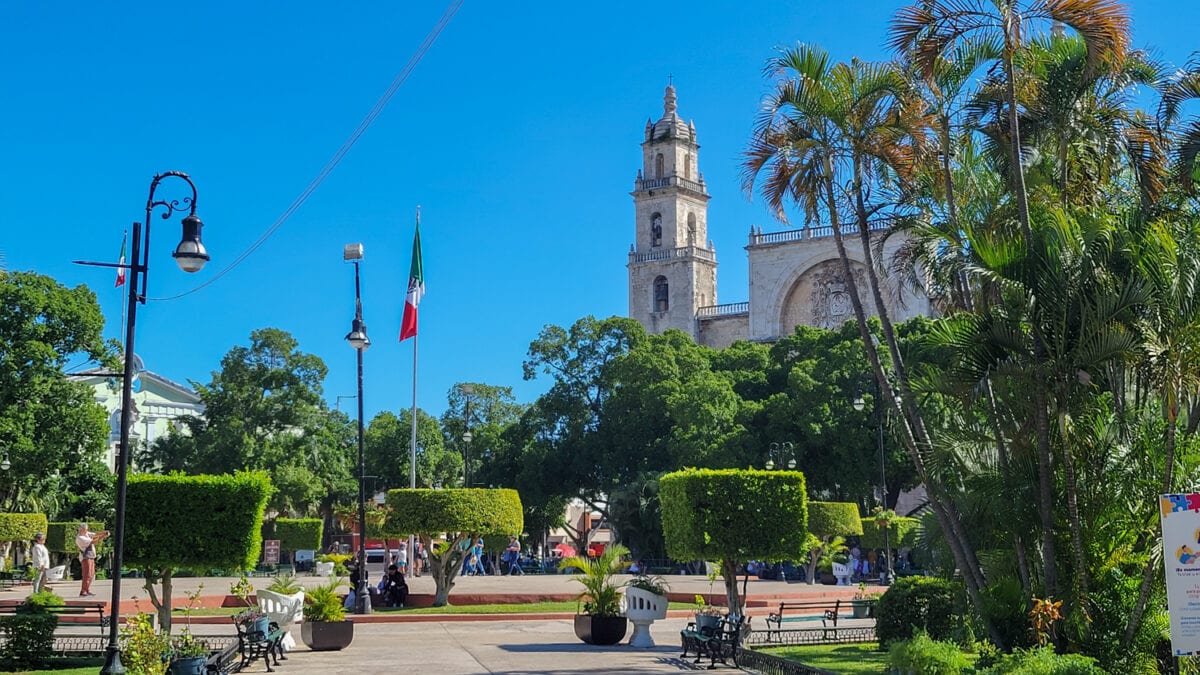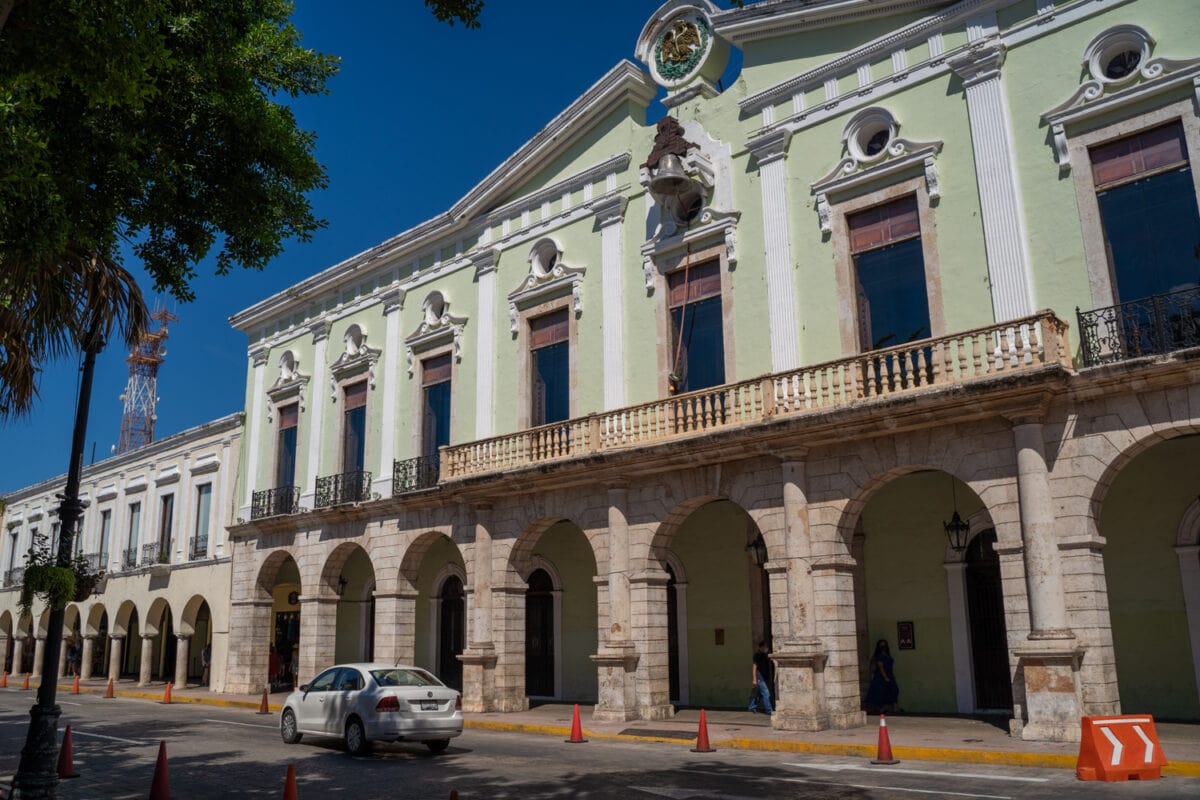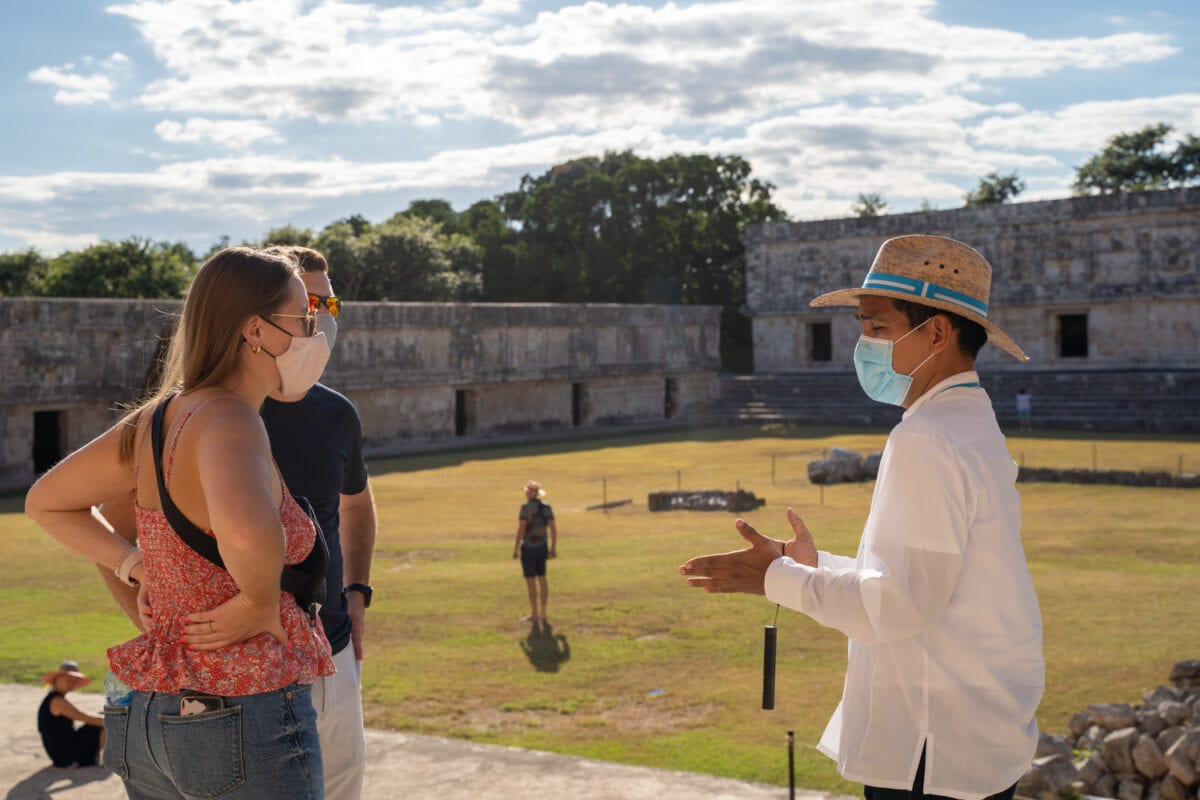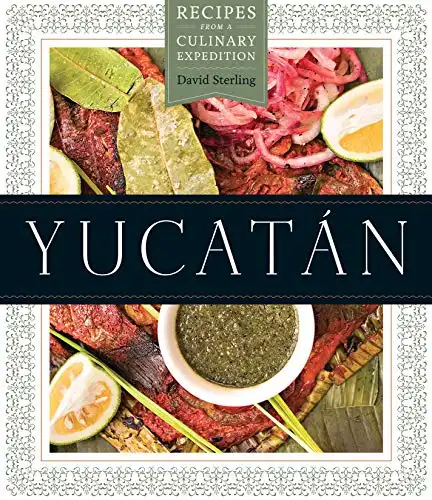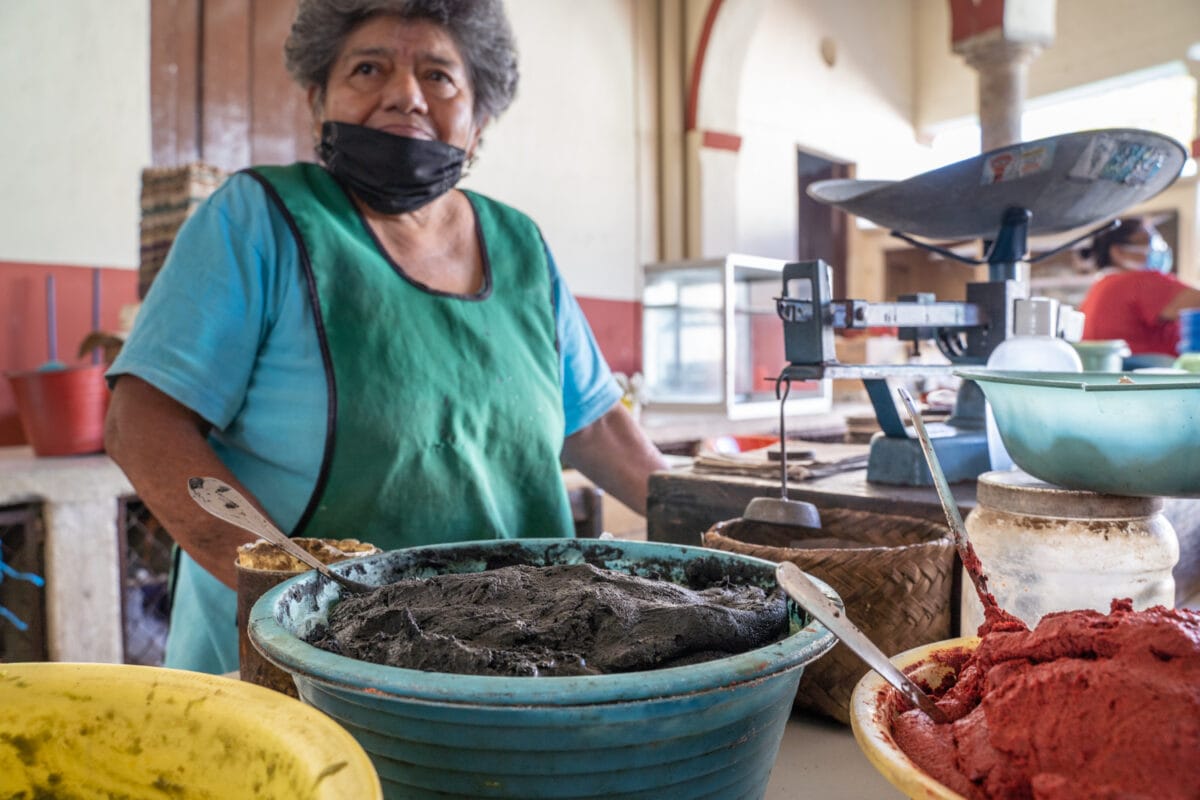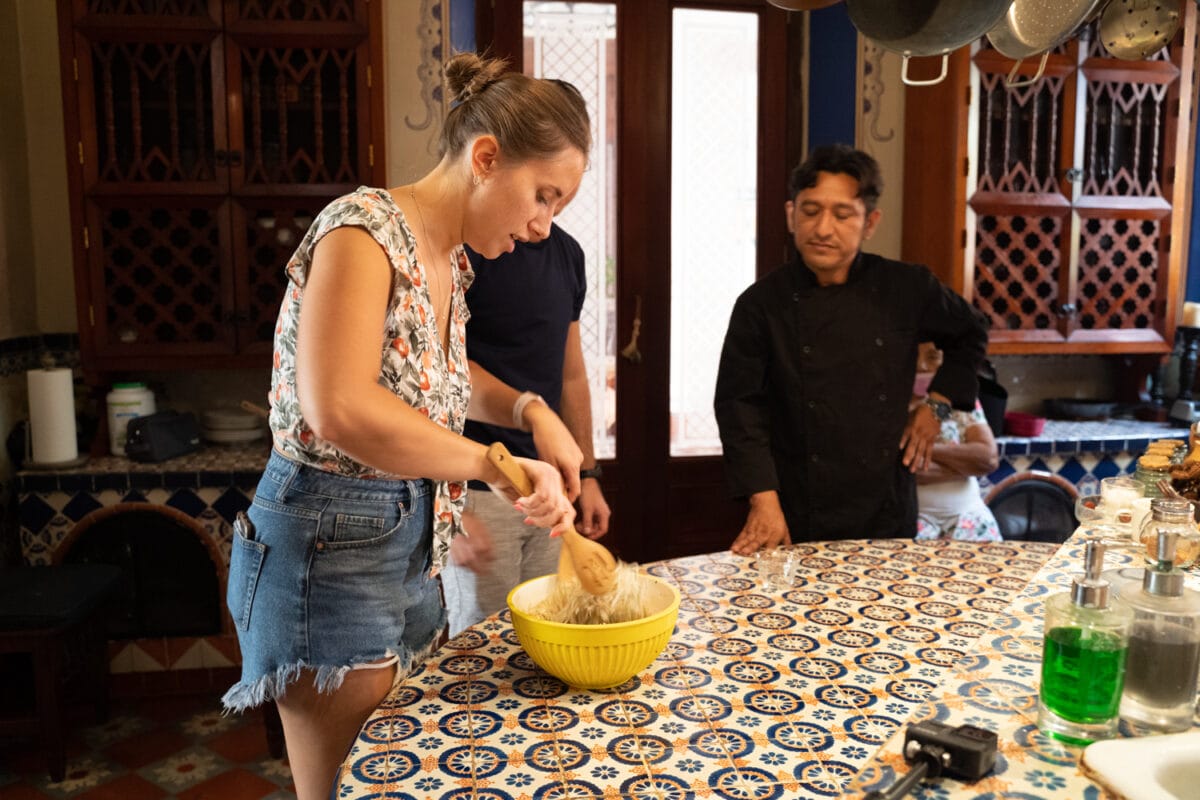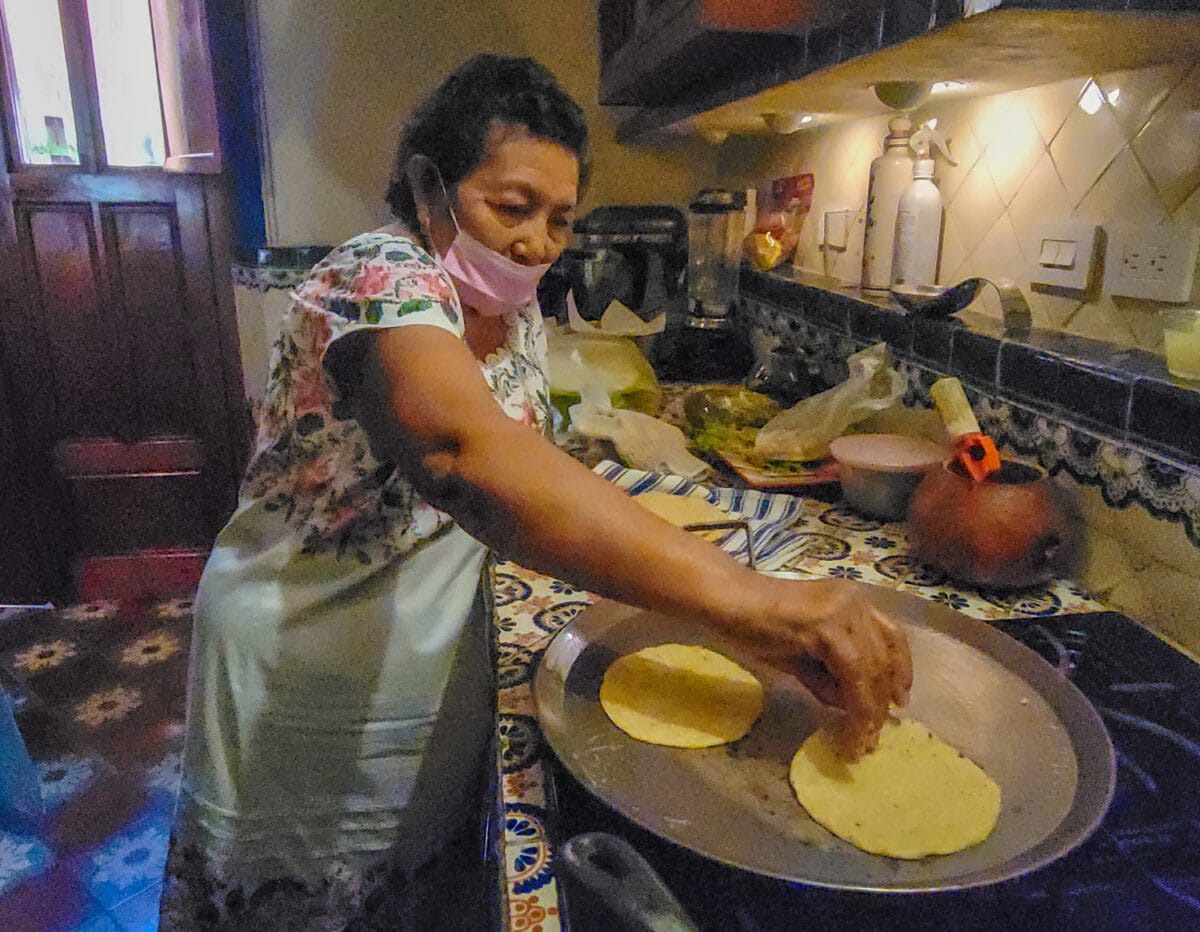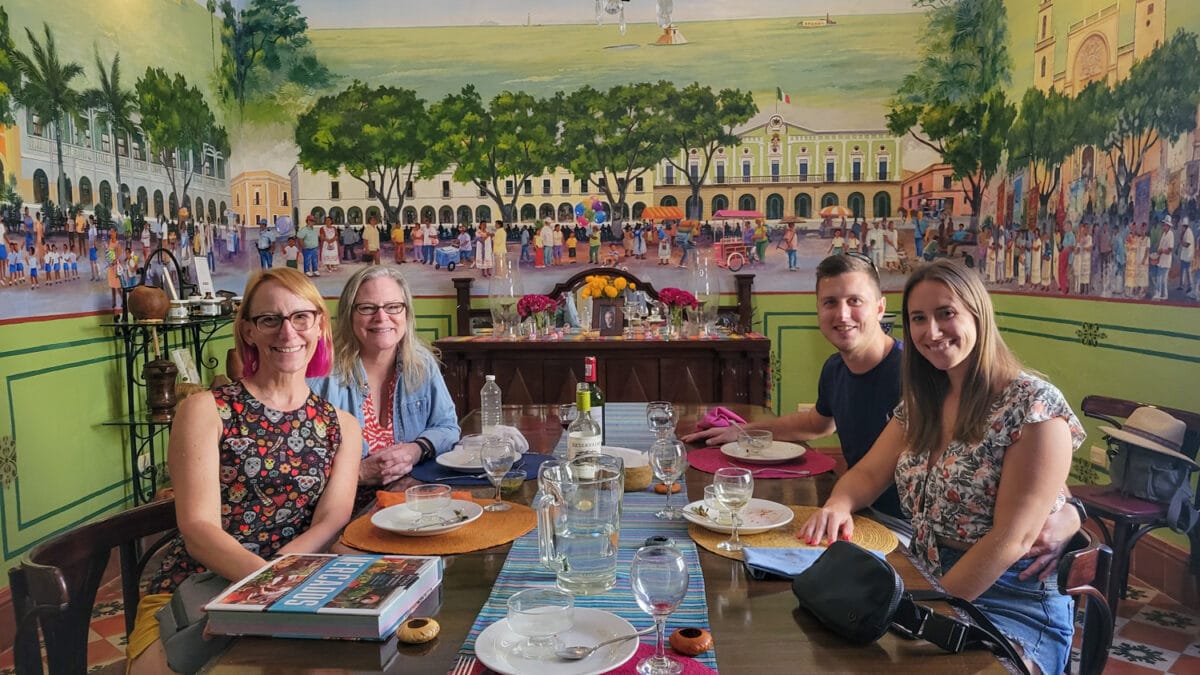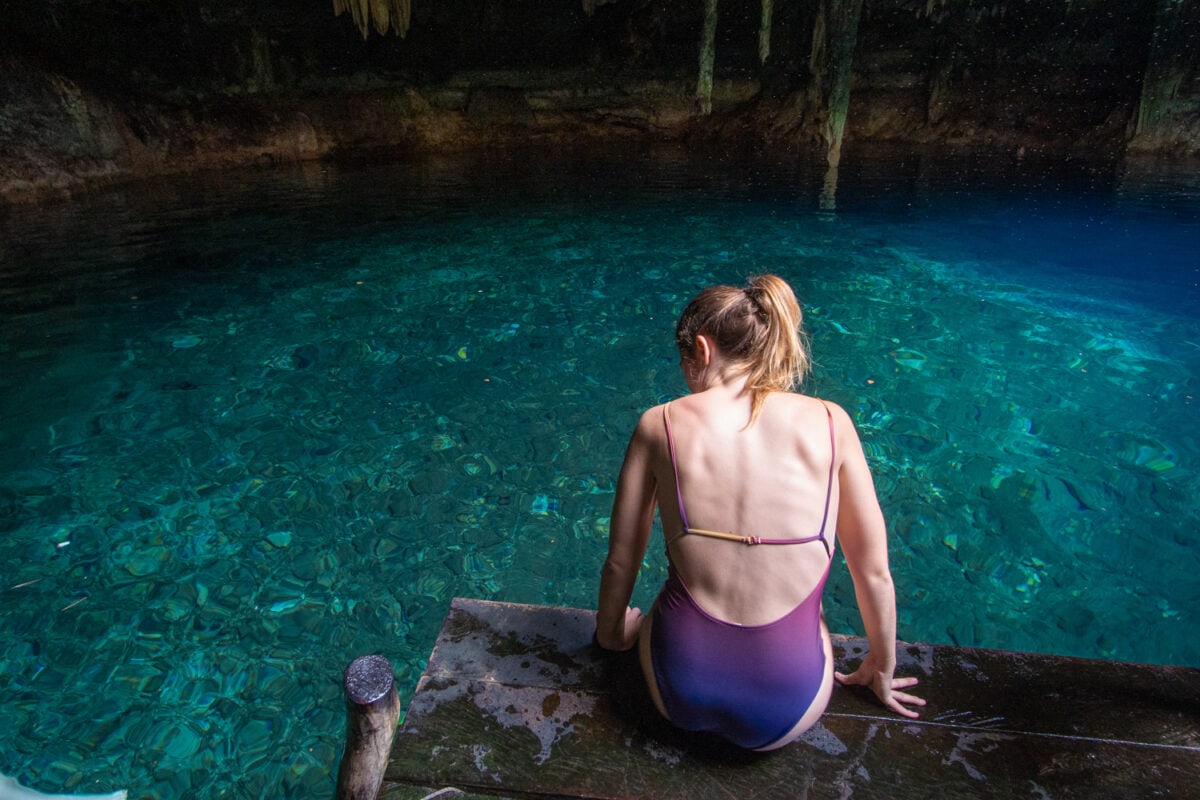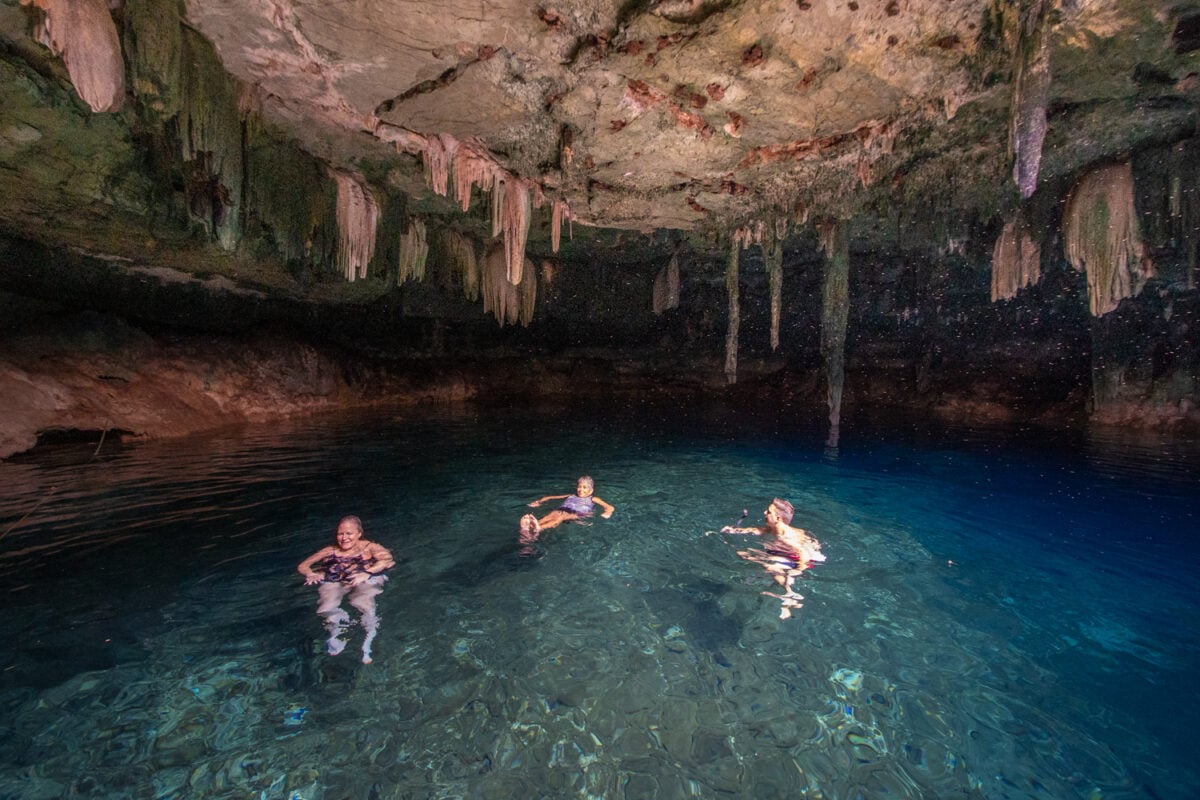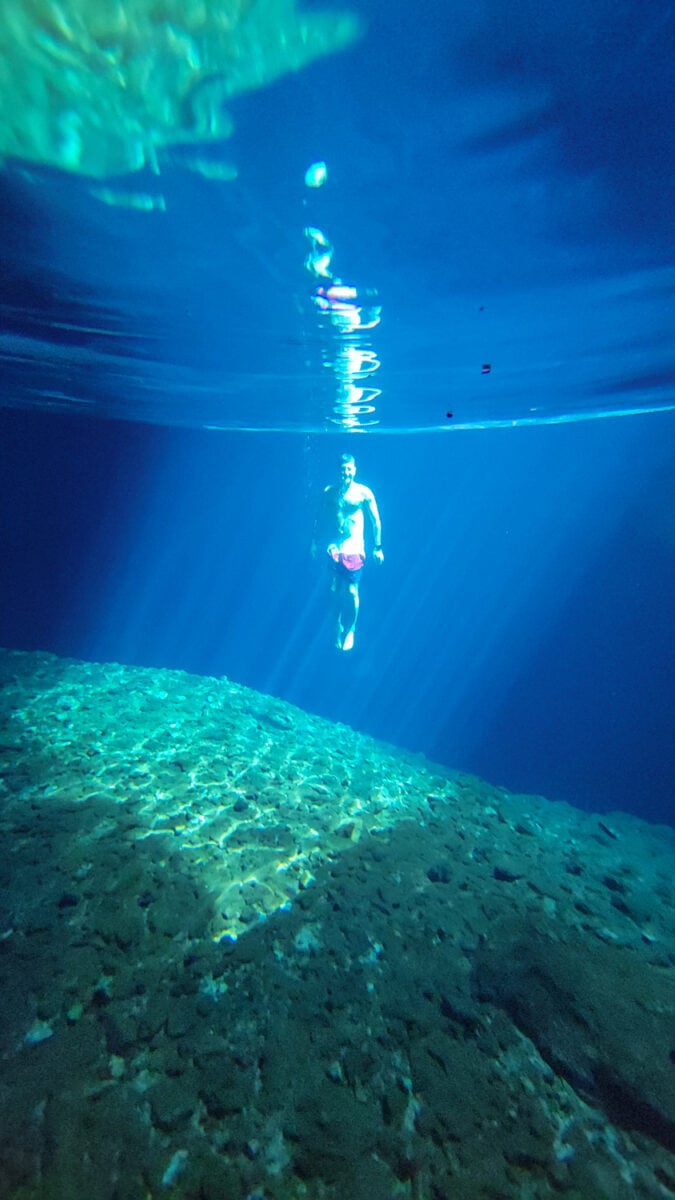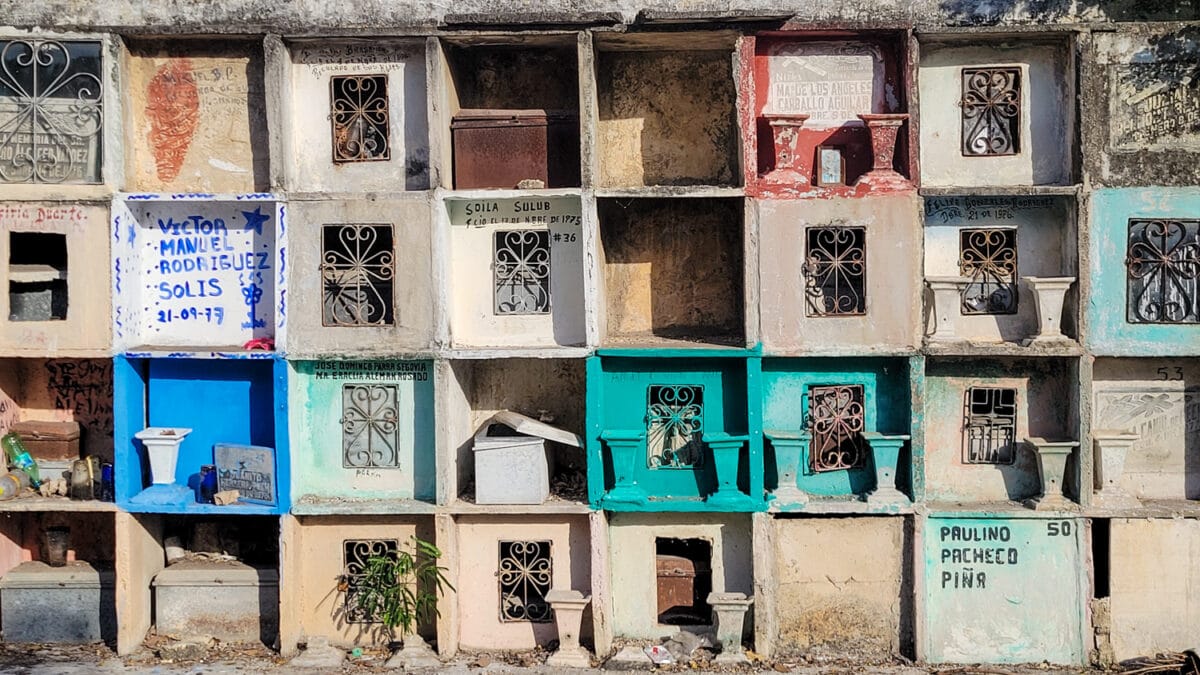Sometimes we overlook the things that are closest to us – it’s human nature. And maybe that explains why I overlooked Mexico in lieu of further-off, more exotic locations. But when I finally reached into the drawer to dust off my passport for the first time since the pandemic, I decided Mérida Mexico was the perfect place to ease back into international travel again.
I usually think of Mexico as somewhat similar to the US culture, but this trip taught me how wrong I was. As our local guide, Raul, answered our many questions about what Mexicans eat for breakfast, what time do people go to dinner, how they celebrate Dia de los Muertos, what is the giant looking lime in the market, why are there boxes on top of graves in the cemetery, etc; I realized Mexico is full of culture that is very different from ours.
And that excited me…

It was the first post-pandemic international travel for each of us on this trip; Bethany (my oldest niece) and her boyfriend Ben, plus my good friends Vicki and Bridget. I was the only person that tied us all together, but we were all willing to roll the dice and go on a group vacation to a place none of us had been before.
Table of Contents
Why Visit Mérida
Mérida is an excellent jumping-off point for learning about and experiencing the Yucatan culture. Named for the ancient Spanish city, Mérida was founded in 1542 by the conquistador Francisco de Montejo y Leon on the site of the Maya city of T’ho. When the Spanish arrived, they had the 5 ancient Mayan pyramids destroyed and used the stones to build the Cathedral de San Ildefonso and the Casa de Montejo. These buildings are now focal points on the La Plaza Grande (the main square).
In addition to the ancient history and colonial buildings, the big draw of Mérida to me is that it is the underdog on the Yucatan Peninsula. What can I say…I love underdogs.
Unlike its neighbor on the peninsula – Cancun- Mérida is not really a tourist town. In fact, I felt like tourism was an afterthought. Even their @VisitMérida Instagram account was in Spanish…telling me that they mainly market to the Mexican population – not Americans. Places like Cancun, Tulum, and Playa de Carmen get the high billing and big tourism dollars – Mérida is an afterthought.
And to top it off, it’s not located on the coast – the closest beach, Progresso, is 30 minutes away, making it a definite underdog.
Visiting Mérida is not your typical Yucatan beach all inclusive vacation – it’s travel to Mexico. The city is encircled by ancient temples, crumbling ruins, sacred cenotes, colorful haciendas, nature reserves, and an abundance of museums and art galleries. This is a place where you want to get out and explore every inch…not be fenced in.
It’s the perfect place to use as a home base as you experience everything the Yucatan has to offer.
Immerse Yourself in Mérida Local Culture
During the lockdown and the ongoing pandemic, I knew that what I missed most about travel was the joy of experiencing new cultures. The best way to experience new cultures, in my opinion, is to immerse yourself in a new place and meet the locals.
That was the focus of my trip, soaking up all of the new culture I could from the locals.
Stay Local in Mérida
One of the first things you can do to immerse yourself in local Mérida culture is to stay in a rental home from Airbnb or VRBO. This way, you feel like you are living there, occasionally cooking meals for yourself, getting to know your neighborhood and local restaurants.
The bed in the master bedroom
We stayed at the incredibly unique Casa de las Torres. This Airbnb rental was an extraordinary colonial home in the heart of historic Mérida, Mexico. The house, originally built in the 1880s by a shop owner, has been renovated by the current owner into a beautiful indoor/outdoor space with some very unusual touches.
One of my favorite things about staying in a rental home when traveling is that it forces me to go to the local stores. And there’s nothing more cultural than staring at a shelf of things trying to figure out if that carton is milk or sour cream! Or looking at produce that you have no idea what it is or what it’s used for.
How to Find a Local Tour Guide
On this trip, I was finally able to use a company that I’ve wanted to try for a long time now – Tours By Locals. Tours By Locals makes it easy to find reliable, experienced, and inspiring local tour guides in 190 different countries. It’s a way for you to craft your own unique tour and do what you want to do on your timeline. It’s a super option for independent travelers.
I booked Raul, a Tours By Locals guide who was from Mérida – he grew up in the neighborhood next to our villa! He had several day trips with itineraries listed. However, you can also customize a trip if there is something specific you want to do that is odd or unusual…like stop at cemeteries or learn more about the stone plates on each corner!
You can read about the local guides, ask them questions, and then choose which one you’d like to hire. You can see Raul’s bio here – I would recommend him in a heartbeat if you are in Mérida!
6 Things to do in Mérida with a Local Focus
1. Los Dos Cooking Class
There’s no better way to learn about the culture than through its food. Anthony Bourdain was a master at looking at a destination through its iconic dishes, so I set out to do the same. And I specifically wanted to learn more about the food traditions around Hanal Pixan – the Yucatan’s Day of the Dead Festival.
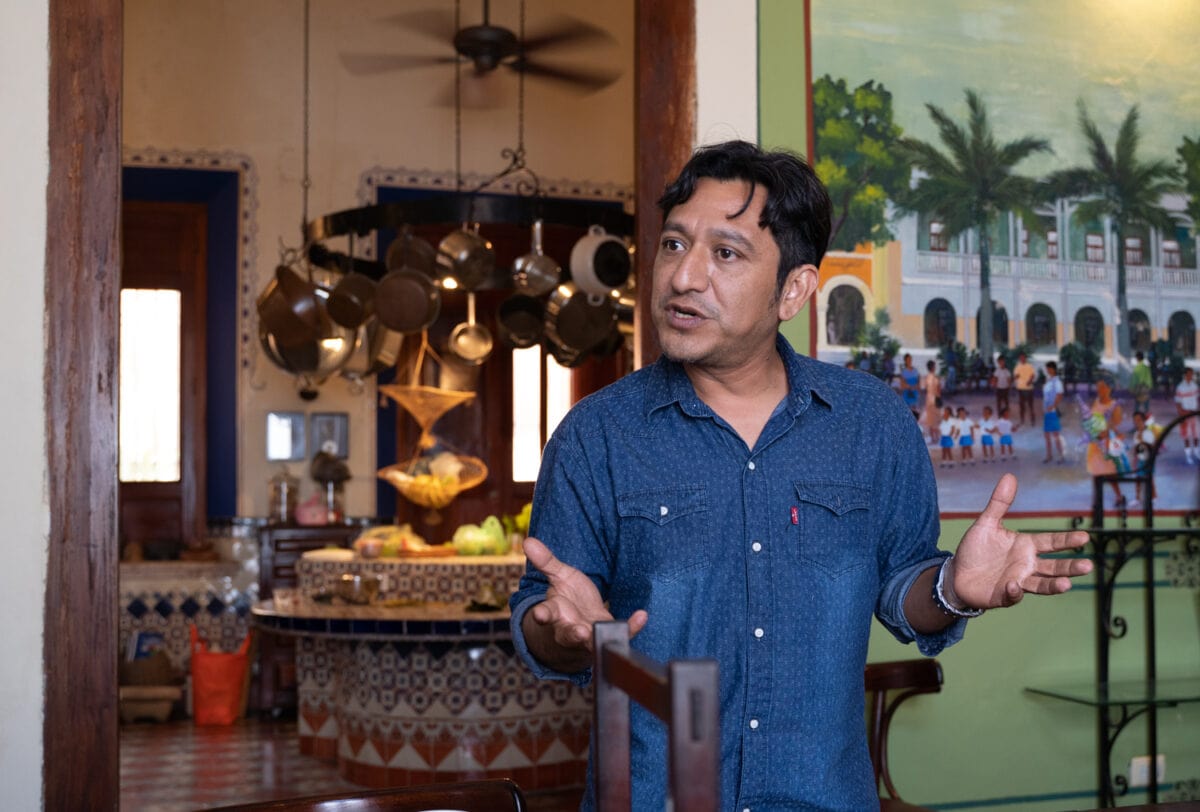
We did a full-day special cooking class on the foods of Hanal Pixan at Los Dos Cooking School. Los Dos is a premier cooking school started by cookbook author David Sterling. David was the author of Yucatán: Recipes from a Culinary Expedition named “Best International Cookbook” and “Cookbook of the Year” by the James Beard Foundation. The thick, beautifully designed book has been praised for its thorough and authoritative documentation of Yucatán’s native ingredients and cooking methods. This recognition is even more impressive since David was an expat and not a native of Mérida.
However, David passed away in 2016. The business was given to his sous-chef – Chef Mario, who grew up in Mérida and learned to cook from his mother. David’s picture sat on the Hanal Pixan altar with a martini glass of gin and a bowl of peanuts. As part of the class, Chef Mario explained the traditions of Hanal Pixan, which is centered around an altar for loved ones that have passed away. The altar typically contains the favorite food and drink of the deceased, candles, pictures, and other memories of the person.
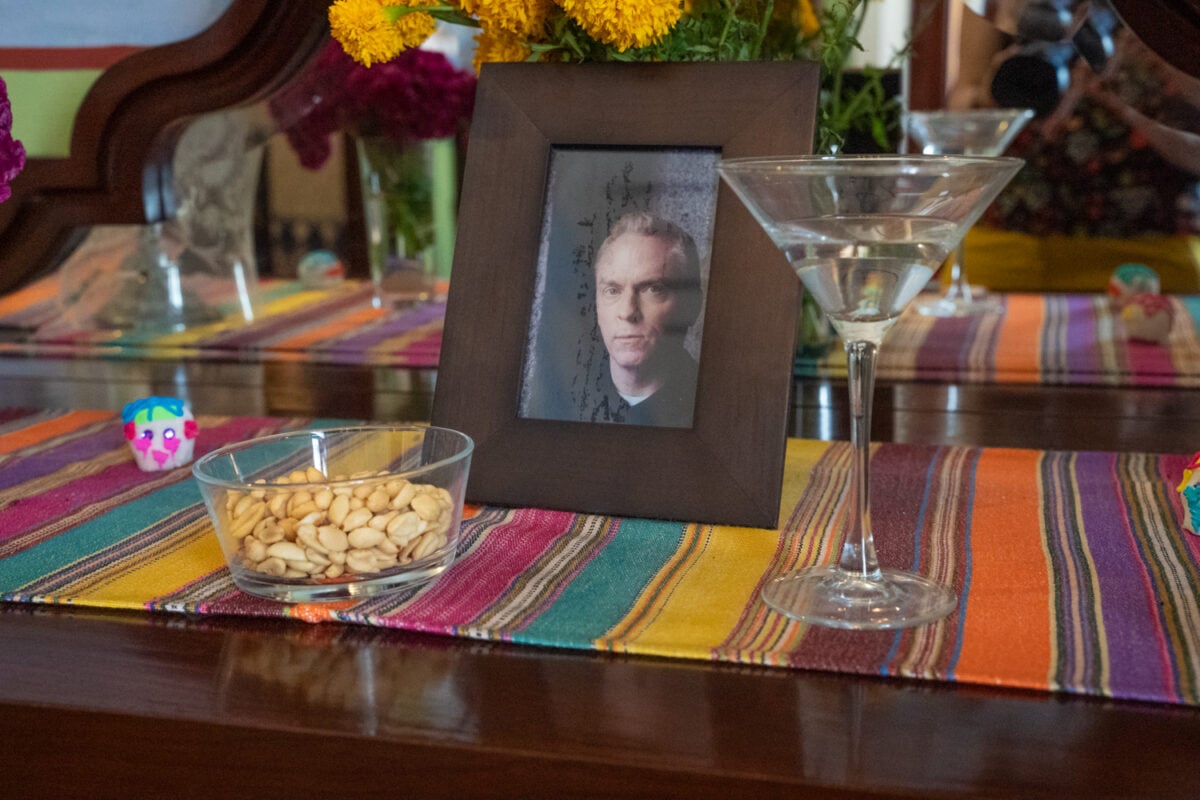
The Los Dos cooking classes include an overview of Maya techniques and ingredients, a market tour, culinary instruction, and a full afternoon meal with drinks.
Mario spent the first 30 minutes telling us the incredibly inspiring story of the cooking school and cookbooks that he and David created. It set a beautiful tone for the entire day. I could feel Chef Mario’s admiration for David as he told the story of how they met and David’s untimely death.
Then we started to dive into the world of Yucatan flavors and pastes. It was fascinating, topped off by a trip to the market with Mario, where he showed us the various ingredients, unusual fruits and vegetables used most often in Yucatan cooking. We picked up a few remaining ingredients and took them back to the cooking school villa.
Now it was time for us to get our hands dirty and start cooking. With the help of three sous-chefs who played the role of a Mexican grandma, we pounded, chopped, processed, fried, flattened, and wrapped the foods into traditional favorites of Hanal Pixan.
The day was filled with eating, drinking, learning, and a glimpse into Mérida’s gastronomy and culture. And it was so much fun!
We did a special Hanal Pixan class, but Mario offers all types of cooking classes. This is a real hands-on, full-day experience where you will learn an immense amount about the region. And you’ll leave stuffed and happy!
3. Bag Some Cenotes
One of the main reasons I wanted to go to Mérida was to experience the famous Yucatan cenotes (pronounced SEE-NO-TAYS). Cenotes are unique to the Yucatan peninsula’s limestone landscape. “Limestone is our soil,” explained Raul as we drove out to the Kankirixche Cenote.
Limestone rock is everywhere, and somehow dense green trees/shrubs grow on the ‘rock soil’, making it all appear very much like you are surrounded by a jungle.
Since limestone is very porous, all of the water drips through the limestone, sometimes pooling in ‘ponds’ of water when it rains. These underground water holes are cenotes. The water filtered through the limestone is typically crystal clear, giving the cenotes idyllic turquoise and blue hues, making it look even more magical and inviting.
There are thousands of cenotes around the Yucatan. They typically come in 3 types: open, partially open, and enclosed (like a cave). Visiting cenotes around Mérida alone could be a whole trip personally – each one is so different. We joked we should try to ‘bag all of the cenotes’ much like people in Colorado have the goal of ‘bagging all of the 14ers’.
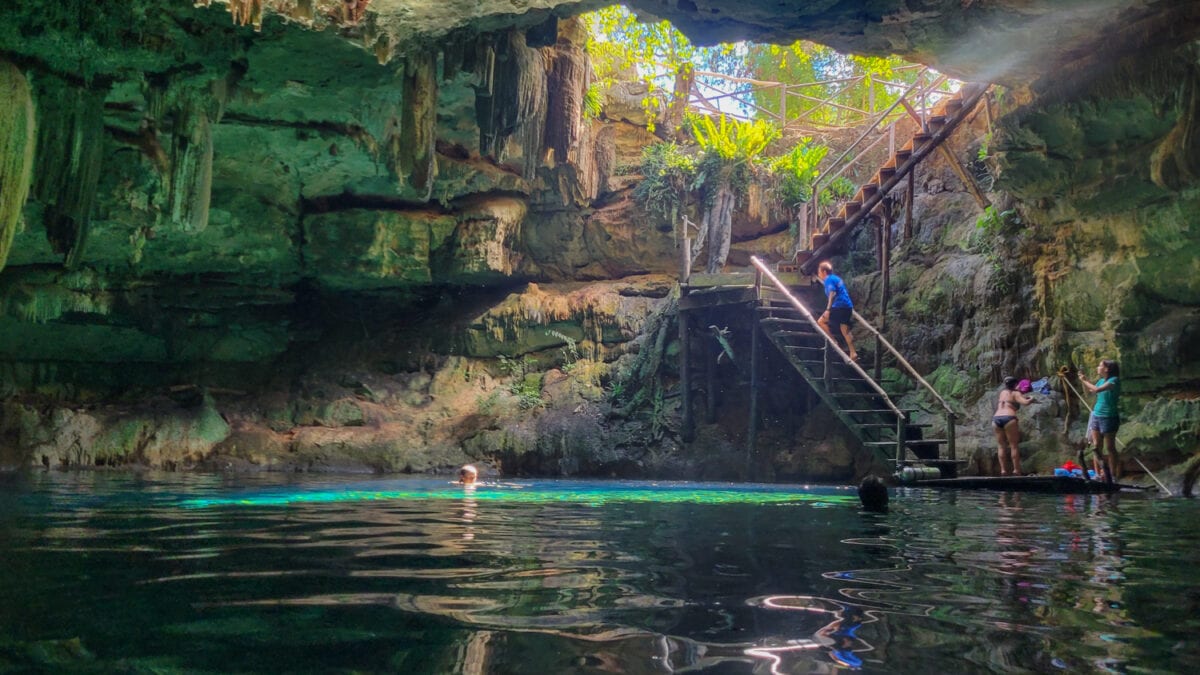
As you might guess, the cenotes are a popular tourist stop, and sometimes they can seem more crowded than the idyllic, remote, calm paradise that they are. But much like with life, timing is everything. Raul gave us his advice on which cenotes to visit and when. Since he was the local expert, we followed his advice and went to the cenote in the morning just as it opened.

We were the first ones at Kankirixche cenote. And there’s nothing more special than having a cenote to yourself. This partially open cenote was absolutely stunning. The water ranged from green to turquoise to deep blue, depending on the depth. Swallows flew around in circles above us, stalagmites dipped down from the cave ceiling, barely touching the blue water. We had this perfection to ourselves for 40 minutes before other people started to arrive.
Later in the week, we went to the San Ignacio, an enclosed cenote. We walked down the steep wooden staircase and immerged into a cave-like oasis deep underground. The water was the clearest I’ve ever seen in my life, and it was completely natural.
We played around in this refreshing underground world, laughing and taking pictures for over an hour before imerging back up into the land of the living.
If you go Cenote bagging on your Mérida vacation – be sure to bring a few of these things:
- Travel Towel – Cenotes don’t offer things like towels
- Goggles – it will make exploring the cenotes under water so much easier!
- Underwater camera – Bring a GoPro!
- Waterproof phone case – I used a waterproof phone case too.

3. Visit Local Markets
The first thing I did in Mérida was to search out and find the local market. It’s my happy place when traveling. It’s where I can observe the locals going about their daily lives, learn about their food and customs, and try new things.
As I wove in and out of the crowds of people, I let my nose lead me to my favorite part of any market.
As soon as I walked into the Mercado San Benito’s meat area and looked around at the hanging meat, a smile formed across my face, and I heard myself mumble, “this is great!” I don’t think I realized how much I had missed markets like this until just that moment. Happiness came over me as I smiled at vendors and took pictures of these hard-working men and women.
I wandered all over the market, purchasing fruits and vegetables from helpful vendors and trying to remember my Spanish numbers! These would be my breakfasts and snacks at the Airbnb for the week.
Whenever you walk through local markets, you’ll inevitably run into products and prepared food that are unfamiliar. I saved all of these questions to ask Raul about. As part of our day out with Raul, we visited a market in the small town of Uman.

I was able to ask all of my questions and try many of the items too! We were introduced to new citrus fruits and sweet potato cookies. However, my highlight was trying a local corn drink (corn and sugar) that I would never have known about if it wasn’t for Raul!
4. Visit the Cemetery
One of my favorite things to do in a country is visit cemeteries. No, I’m really not a weirdo; I actually think that there’s a lot to learn about a country in their cemeteries. In Mérida, there are some unusual rituals around the cemeteries that I had never heard of before. Bodies are buried underground, but after 3 to 5 years, bones are removed, cleaned, and placed in a box. The box sits on top of the grave in a small altar forever after. Each year, the week before Hanal Pixan, the bones are removed from the box and cleaned to prepare for their’ trip to visit their loved ones’ during Hanal Pixan.
I went and visited the General Cemetery (Cementerio General) in Mérida to get a look at this unusual ritual. The cemetery was surprisingly colorful and crowded. The gravesites were all really close together and in various stages of crumbling – which made for some very moody photography.
5. Eat at the Neighborhood Markets
The markets aren’t just for buying produce and meat; you can eat there too. In fact, you’ll find some of the best food in little neighborhood markets for much less than in a restaurant. On Raul’s advice, we also visited the San Sebastián market in the neighborhood he grew up in. He told us exactly where to go and what to order – Huevos Motulenos. Motulenos is a popular local breakfast food made with eggs on tortillas, ham, peas, salsa, black beans, cheese, and plantains; it was delicious!

6. Walk Through Neighborhoods
Each day we’d spend time walking around a neighborhood and just taking in everything around us. For my friend Viki – this led to an incredible local discovery that was quite obscure and interesting.

She noticed a stone plate/etching a corner building. She didn’t think much of it but started seeing them on more corners. But each one was different. Viki began taking pictures of them every time we went out walking. We all wondered what in the world they were or what they represented. There were so many – we knew it had to have meaning.
We asked Raul about them when he picked us up and learned that they were historical markers that few people even noticed. The story about these markers has to do with the fact that many people couldn’t read or write when the city was settled. So the corners were recognized by stories of what happened there.
The story was the address!
The city has now preserved this idea by marking the corners with stone plate images of how they were known and referred to.

To get the entire and very cool story about these stone plates – check out this article Viki wrote up after her extensive research!
Stay a Week and Use Mérida As Your Home Base
I pulled together a group of random friends to join me at my Airbnb, and we split the costs. It was our first international trip post-pandemic for each of us. But we were all eager to get out, and Mérida was the perfect place to dip a toe back into travel. It can easily be used as a home base to the region so that you can get a mix of the colonial town, local culture, beach, and cenotes.

Even though they were all strangers to each other – the world of travel brought us together. Each person on this trip brought me joy. Bridget proved that you can truly work from anywhere as she held meetings by the pool. Viki reminded me of what it’s like to do international travel for the first time (it was her first trip to Mexico), and her enthusiasm was infectious. Bethany made me proud as she gushed with curiosity about the Mayan temples and history…something she used to hate as a kid. And Ben’s enthusiasm for trying everything local… especially the habanero sauce, made me happy.

Travel is what brought this unlikely group together …and it was wonderful ..a real vacation. I realize that I’ve overlooked Mexico…and it’s right in my backyard. Mérida was a little hidden gem of history and culture that made me feel as if I had traveled across oceans, but it was only 4 hours of flying away!

